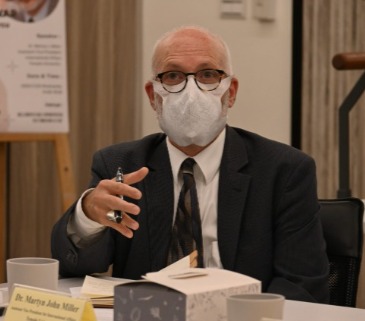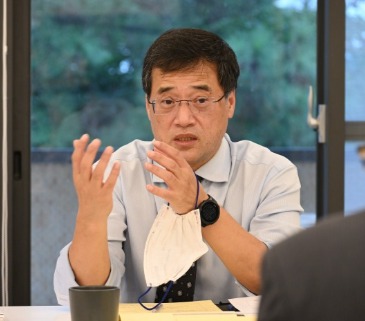TM x NTU x NYCU EMI SEMINAR



歡迎天普大學副校長MARTYN JOHN MILLER、臺大雙語教育中心與臺大EMI教學資源中心來訪陽明交通大學,進行EMI學術研討會
Time:
Nov 23, 2022(Wed.) 14:30-17:30
Venue:
Zhi Xing Building (front) room 203
Sharing:
- Temple experience
- Why bilingual education?
- Divergent thinking, memory, reasoning, and problem-solving abilities
- Awareness and appreciation of different cultures
- Flexibility, adaptability, and openness in attitude
- Globalization: language learning is central to politics, economics, history, and education
- Concerns
- Can we really trust current English proficiency tests (TOEFL, CEFR, IELTS, etc.)?
- They could be biased.
- Students with high test scores can’t really deliver their professional knowledge in English.
- Is money the best motivation?
- It won’t be sustainable.
- International personnel costs more than local personnel
- Does the government have a commitment to them?
- Is CEFR B2 level enough for students to take EMI courses?
- B2 is only daily conversation; C1 is more suitable for most academic studies, because C1 students
- Speak English fluently and spontaneously
- Do not see English as intimidating
- Why don’t we start preparing students for B2 level at high school, and help them reach C1 level in the first year of university?
- B2 is only daily conversation; C1 is more suitable for most academic studies, because C1 students
- Can we really trust current English proficiency tests (TOEFL, CEFR, IELTS, etc.)?
- Temple’s strategies
- For faculty development
- Improve faculty on English proficiency and pedagogy: extended pedagogy workshops
- 1 to 2 days, for more than 2 hours/each, conducted in English
- Not just teach English, but also pedagogy
- Peer teaching with foreign faculty member
- Classroom observation through objective, non-threatening methods
- When an outsider walks in the classroom, it really scares both the students and the teacher.
- Provide resources on teaching international students
- Making teaching award winners mentors
- Improve faculty on English proficiency and pedagogy: extended pedagogy workshops
- For students’ language proficiency
- 2 day intensive orientation
- Student leadership: encourage students to lead something
- International Student Advisory Board
- Temple Student Government
- Student Worker Positions
- International students’ working opportunity
- Student Success Center
- (Low stress/ must speak English)
- Language Tutor
- Writing and Research Retreats
- Academic coaching
- Conversation hours
- International coffee hours (the problems they’re facing in their countries right now)
- For faculty development
- Why bilingual education?
- Open discussion
- Question: Although at least 60% of students in NYCU reach CEFR B1 level, students’ English proficiency is still one big challenge in EMI courses. Any good strategy for this?
- In their freshman year, spend more time/ put more English language courses in the curriculum to enhance their English proficiency.
- Peer teaching: students learn more from their classmates
- What Temple did: intensive 4-week language training before the semester begins for those with lower English proficiency
- It’s conditional.
- Statistics have shown that it’s enough to help them go through EMI courses
- Ideally no more than 15 students/per class; maximum 18 students; with 1 instructor
- Question: How can we find an EMI teacher’s true passion or motivation?
- Select high motivated EMI teachers
- Question: How do we encourage students? How can we use all these resources to maximize the impact?
- Many medical students think that they’ll eventually be serving local people, so they don’t care about being bilingual or not.
- They’ll need to speak not only Mandarin, but also dialects, Hakka, etc. There stands the importance of picking up another language.
- To maximize the impact of all the resources, think about collaboration.
- Lots of students from NYCU Hsinchu campus (most with engineering background) want to work abroad/in an international company, which serves as a good incentive
- Students care about their professional development outcomes, so tell them how much money they can make by adding a language
- Suggestion: immerse students more in the bilingual environment
- Open EMI classes consistently (every semester)
- Use english to study
- Many medical students think that they’ll eventually be serving local people, so they don’t care about being bilingual or not.
- Question: In Taiwan, the students are not ready to become bilingual yet, but the government is pushing. Has Dr. Miller observed any similar situation in other universities?
- Dr. Miller: I don’t really have this kind of experience. But, Canada is the model. It’s been only 20~30 years for them to come this far, becoming bilingual. We need to learn from them.
- Different motivation
- Canada (supporting environment)
- Has a national definition of “bilingual”
- Government employees need to pass French tests
- Collected resources
- Taiwan (top-down policy)
- Money from government is not stable/ sustainable
- “You can give me lots of money but you can’t buy Chinese out of me.”
- Do people really need English in Taiwan?
- Canada (supporting environment)
- Suggestion: The nation needs to embrace this policy as a whole, and to accept English as a second language. Until then, promoting EMI courses won’t be easy.
- Suggestion: to create EMI teaching awards
- For teachers who really generate impact to the society
- Sharing: challenges in NTU
- Although student’s English proficiencies are better, NTU still works on improving it
- 全英培力課程: teach about the foundation of language
- Activities to create bilingual environment: English corners, workshops, etc
- 3MT competition
- Authorized by University of Queensland
- Participants are coached 1 by 1
- The winner goes to Australia for further competition
- These activities are actually quite popular: about 4,000 students participated
- NTU doesn’t intend to separate students from faculties. These activities are for both the students and the faculty
- Real challenge: finding those students who have the potential/ they don't have the opportunity to show their potential
- Although student’s English proficiencies are better, NTU still works on improving it
- Question: Speaking of motivated/ not-motivated/ likely to be motivated students, what kind of students should we focus on in the long run?
- Ans: students who are likely to be motivated
- We aim for the potential, see it as an investment.
- Suggestion: when the problem goes back to the policy maker
- The KPI of current policy is not realistic. 10 years is not enough to achieve it.
- Communicate or negotiate with the government side/ speak up to MOE
- Education is an economic engine. Show them how the BEST program will bring in money.
- The USA has realized that education is a business. Economic impact indicators are made to prove that point. It took almost 20 years for the USA to bring industry in, then the money will speak up. (Reference: 2022 Economic Report of the United States)
- Question: Although at least 60% of students in NYCU reach CEFR B1 level, students’ English proficiency is still one big challenge in EMI courses. Any good strategy for this?
